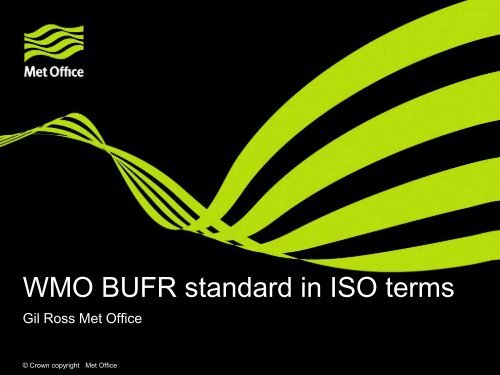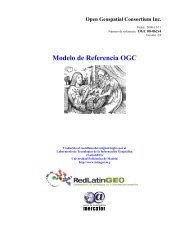WMO BUFR standard in ISO terms - Open Geospatial Consortium
WMO BUFR standard in ISO terms - Open Geospatial Consortium
WMO BUFR standard in ISO terms - Open Geospatial Consortium
Create successful ePaper yourself
Turn your PDF publications into a flip-book with our unique Google optimized e-Paper software.
<strong>WMO</strong> <strong>BUFR</strong> <strong>standard</strong> <strong>in</strong> <strong>ISO</strong> <strong>terms</strong><br />
Gil Ross Met Office<br />
© Crown copyright Met Office
Contents of talk<br />
© Crown copyright Met Office<br />
• Historical background<br />
• Does <strong>WMO</strong> do data modell<strong>in</strong>g?<br />
• <strong>WMO</strong> data exchange – formats and volumes<br />
• What does <strong>BUFR</strong> look like<br />
• <strong>BUFR</strong> data modell<strong>in</strong>g<br />
• <strong>BUFR</strong> Tables are they the <strong>BUFR</strong> catalogue?<br />
• Is this like a feature catalogue?<br />
• Not exactly - <strong>BUFR</strong> modifiers can change the mean<strong>in</strong>g of<br />
features.<br />
• Can this map to <strong>ISO</strong> structures?<br />
• Some conclusions
<strong>WMO</strong> data exchange<br />
• 1873 - International Meteorological<br />
Organization<br />
• 1951 – <strong>WMO</strong> was created a UN Agency<br />
• 1963 – UN sets up WWW (World Weather<br />
Watch)<br />
• A WWW programme, <strong>WMO</strong> Data Management<br />
is tasked with:<br />
• management of meteorological data and products<br />
• <strong>standard</strong>ised representation of data and metadata<br />
• monitor<strong>in</strong>g of data availability and quality.<br />
© Crown copyright Met Office
<strong>WMO</strong> data modell<strong>in</strong>g<br />
• Did <strong>WMO</strong> do ANY data modell<strong>in</strong>g?<br />
• data modell<strong>in</strong>g was not considered a separate process until<br />
much later<br />
• Implicit data modell<strong>in</strong>g was part of the data representation<br />
process whose task focus was to produce data codes <strong>in</strong> order<br />
to exchange data<br />
• WWW adopted and adapted exist<strong>in</strong>g pre-war and wartime<br />
codes.<br />
• Alphanumeric codes (TACs)<br />
• SYNOP METAR SHIP SYREP CLIMAT TEMP PILOT MOBIL<br />
ROCOB SATEM AMDAR MAFOR BATHY TRACKOB ASDAR<br />
SAREP SATOB SFAZI SFLOC HYDRA HYFOR TESAC FLEET<br />
ICEAN TAF etc. etc.<br />
• Most of these have 5-letter names<br />
• sent by Morse Code over radio (and teletype) so used Morse<br />
convention of break<strong>in</strong>g codes and cyphers <strong>in</strong>to 5 – groups.<br />
• MANY OF THESE CODES ARE STILL IN USE.<br />
© Crown copyright Met Office
Table Driven Codes<br />
• TACs are <strong>in</strong>flexible and hard to extend to new data.<br />
• Concept of Table Driven Codes adopted <strong>in</strong> mid ’80s<br />
• <strong>BUFR</strong><br />
• GRIB<br />
• B<strong>in</strong>ary Universal Form for the Representation of meteorological<br />
data<br />
• Operational 1988<br />
• GRIdded B<strong>in</strong>ary<br />
• Operational 1994<br />
• CREX<br />
• Character form for the Representation and EXchange of data<br />
• Semi-operational 1994<br />
© Crown copyright Met Office
Traditional Alphanumeric<br />
Codes<br />
• They are “human readable” and all<br />
observers/forecasters could code and decode<br />
them – once upon a time.<br />
• Many are now only mach<strong>in</strong>e read but METAR<br />
(Aerodrome Rout<strong>in</strong>e Meteorological Report)<br />
• Heathrow:<br />
EGLL 071245Z 28022KT 240V290 9999<br />
FEW020TCU 13/07 Q1011<br />
• Bristol:<br />
EGGD 071250Z 28015KT 250V310 9999 FEW020<br />
12/07 Q1012 NOSIG<br />
• METARs are still read daily by ~ 2 million pilots<br />
© Crown copyright Met Office
© Crown copyright Met Office<br />
Table Driven Codes<br />
• Difference between <strong>BUFR</strong> and GRIB (generally)<br />
• GRIB is for uniform (multidimensional) array coverages<br />
• <strong>BUFR</strong> is for po<strong>in</strong>t coverages us<strong>in</strong>g keyword pairs (hashes <strong>in</strong> perl,<br />
dictionaries <strong>in</strong> python)<br />
• <strong>BUFR</strong> Codes (keyword pairs) are "self-descriptive“<br />
• the description and content of the data are both conta<strong>in</strong>ed with<strong>in</strong> the<br />
<strong>BUFR</strong> message itself<br />
• Unlike XML elements (or hashes and dictionaries), keyword pairs<br />
are split <strong>in</strong>to descriptor groups and data groups allow<strong>in</strong>g<br />
<strong>in</strong>dependent compaction techniques<br />
• All descriptors are referenced<br />
• All coded values are referenced<br />
• All numbers are converted to predef<strong>in</strong>ed bit length<br />
• Same era as SGML (1986), similar philosophy<br />
• BUT<br />
• <strong>BUFR</strong>, CREX and GRIB have brevity as a major design<br />
requirement for data exchange
<strong>BUFR</strong> <strong>in</strong> use<br />
• Migration to Table Driven Codes<br />
• Major <strong>WMO</strong> program to convert to TDCs away from TACs<br />
• UKMO spend<strong>in</strong>g > £1/2 Million<br />
• Estimate that Europe spend<strong>in</strong>g > € 10 Million<br />
• Currently UKMO receives ~ 200,000 <strong>BUFR</strong> bullet<strong>in</strong>s<br />
(<strong>in</strong>stances) every day – and <strong>in</strong>creas<strong>in</strong>g<br />
• Currently convert<strong>in</strong>g TACs directly <strong>in</strong>to <strong>BUFR</strong> templates<br />
• SYNOP, for example has 90 possible elements<br />
• Template has locations for all of these<br />
• Plus local options<br />
• Intention is not to be constra<strong>in</strong>ed by current templates,<br />
but to publish many more templates or def<strong>in</strong>e the<br />
template entirely with<strong>in</strong> the <strong>in</strong>stance.<br />
© Crown copyright Met Office
© Crown copyright Met Office<br />
(24/2/2010, 0 UTC, quoo)
What does <strong>BUFR</strong> look like?<br />
• Extremely succ<strong>in</strong>ct<br />
• The usual decoded form is highly structured<br />
• So an XML representation is straightforward<br />
• However, the usual decoded form has components of the<br />
<strong>BUFR</strong> data model still present<br />
• These need further decipher<strong>in</strong>g to <strong>in</strong>terpret the mean<strong>in</strong>g<br />
• Experts can do this, but not everyone is an expert<br />
• This decipher<strong>in</strong>g is not done uniformly. Every user who<br />
decodes <strong>BUFR</strong> to put <strong>in</strong>to its databases has programmed<br />
the deciphered mean<strong>in</strong>g<br />
• Everyone has programmed it differently.<br />
© Crown copyright Met Office
© Crown copyright Met Office<br />
• Subset<br />
• F0X01Y001 : BCID_<strong>WMO</strong>block : 3 : NUMERIC<br />
• F0X01Y002 : BCID_<strong>WMO</strong>station : 220 : NUMERIC<br />
• F0X01Y015 : BCID_stationName : CARLISLE : CCITT IA5<br />
• F0X02Y001 : BCIn_station : 0 : CODE TABLE<br />
• F0X04Y001 : BCT_year : 2010 : YEAR<br />
• F0X04Y002 : BCT_month : 8 : MONTH<br />
• F0X04Y003 : BCT_day : 2 : DAY<br />
• F0X04Y004 : BCT_hour : 17 : HOUR<br />
• F0X04Y005 : BCT_m<strong>in</strong>ute : 50 : MINUTE<br />
• F0X05Y001 : BCX_hiPrecsnLat : 54.93 : DEGREE<br />
• F0X06Y001 : BCY_hiPrecsnLon : -2.97 : DEGREE<br />
• F0X07Y030 : BCV_stationHeight-MSL : 28 : M<br />
• F0X07Y031 : BCV_barometerHeight-MSL : 27 : M<br />
• F0X10Y004 : BVP_pressure : 101360 : PA<br />
• F0X10Y051 : BVP_MSLP : 101690 : PA<br />
• F0X10Y061 : BVP_pressureChange3Hr : -20 : PA<br />
• F0X10Y063 : BVP_pressureCharacteristic : 8 : CODE T<br />
• F0X12Y101 : BT2_DryBulbTemp : 290.35 : K<br />
• F0X12Y103 : BT2_DewPo<strong>in</strong>tTemp : 285.75 : K<br />
• F0X07Y032 : BCV_heightSensor-Platform : MISSING : M<br />
• F0X20Y001 : BObs_horizontalVisib : 45000 : M<br />
• /Subset
© Crown copyright Met Office<br />
So far – all about codes<br />
what about data modell<strong>in</strong>g?<br />
• <strong>BUFR</strong> Tables are the <strong>WMO</strong> equivalent of a catalogue<br />
• Tables A, B, C and D, Code/Flag tables, Common Code tables<br />
• Can split the tables <strong>in</strong>to cod<strong>in</strong>g tables and modell<strong>in</strong>g tables<br />
• Cod<strong>in</strong>g Tables<br />
• Table C cod<strong>in</strong>g operations (precision changes, bit map operations,<br />
quality operators)<br />
• Table D has 20 classes of templates ( which are macros not<br />
modules) which list predef<strong>in</strong>ed lists of descriptors and operators.<br />
• Modell<strong>in</strong>g Tables<br />
• Table A is list of data categories<br />
• Table B is 29 classes of two types of data descriptors conta<strong>in</strong><strong>in</strong>g ~<br />
1500 descriptors.<br />
• Code/Flag Tables are 377 tables of codes and enumerations and<br />
flags – multi-value codes.<br />
• Common Code Tables are 12 Code tables used across <strong>BUFR</strong> GRIB<br />
and TACs
<strong>BUFR</strong> descriptor classes<br />
• Two Types Modifiers and descriptors<br />
• Modifier Classes<br />
• 01 Identification<br />
• 02 Instrumentation<br />
• Def<strong>in</strong>es <strong>in</strong>strument types used<br />
• 04 Location (time)<br />
• Def<strong>in</strong>es time and time derivatives<br />
• 05 Location (horizontal - 1)<br />
• Def<strong>in</strong>es geographical position, <strong>in</strong>clud<strong>in</strong>g horizontal derivatives<br />
• 06 Location (horizontal - 2)<br />
• Def<strong>in</strong>es geographical position, <strong>in</strong>clud<strong>in</strong>g horizontal derivatives<br />
• 07 Location (vertical)<br />
• Def<strong>in</strong>es height, altitude, pressure level, <strong>in</strong>clud<strong>in</strong>g vertical<br />
derivatives of position<br />
• 08 Significance qualifiers<br />
• Def<strong>in</strong>es special character of data<br />
© Crown copyright Met Office
© Crown copyright Met Office<br />
<strong>BUFR</strong> Modifiers<br />
• <strong>BUFR</strong> Modifiers<br />
• Change the descriptors or simple features<br />
• They change the simple features WITHIN an <strong>in</strong>stance (a <strong>BUFR</strong><br />
Bullet<strong>in</strong>)<br />
• Rather like a DTD<br />
• They group simple features <strong>in</strong>to a collection<br />
• They create feature attributes<br />
• identity, location (parametric x,y, and z), time, location and time<br />
ranges, <strong>in</strong>strumentation, roles, quality <strong>in</strong>fo<br />
• They create Discrim<strong>in</strong>atedFeatures (<strong>ISO</strong>19126)<br />
• E.g. discrim<strong>in</strong>ate a temperature feature to be a different<br />
temperature type, e.g. period extreme, sea surface, ground<br />
temperature<br />
• They create Discrim<strong>in</strong>atedFeatures and def<strong>in</strong>e another<br />
dependent coord<strong>in</strong>ate<br />
• E.g. discrim<strong>in</strong>ate temperature feature to become an upper-air<br />
temperature measured at a (set of) pressure, geopotential or height
<strong>BUFR</strong> Descriptors<br />
11 W<strong>in</strong>d and turbulence 12 Temperature<br />
13 Hygrographic and hydrological elements 14 Radiation and radiance<br />
15 Physical/chemical constituents 19 Synoptic features<br />
20 Observed phenomena<br />
Def<strong>in</strong>es present/past weather, special phenomena, etc.<br />
21 Radar data 22 Oceanographic elements<br />
23 Dispersal and transport 24 Radiological elements<br />
25 Process<strong>in</strong>g <strong>in</strong>formation<br />
29 Map data 30 Image<br />
31 Data description operator 33 Quality <strong>in</strong>formation<br />
35 Data monitor<strong>in</strong>g <strong>in</strong>formation 40 Satellite data<br />
10 Vertical elements and pressure<br />
Height, altitude, pressure and derivatives observed or measured, not def<strong>in</strong>ed as a<br />
vertical location<br />
26 Non-coord<strong>in</strong>ate location (time)<br />
Def<strong>in</strong>es time and time derivatives that are not coord<strong>in</strong>ates<br />
27 Non-coord<strong>in</strong>ate location (horizontal -1)<br />
Def<strong>in</strong>es geographical positions that are not coord<strong>in</strong>ates<br />
28 Non-coord<strong>in</strong>ate location (horizontal - 2)<br />
Def<strong>in</strong>es geographical positions,, that are not coord<strong>in</strong>ates<br />
© Crown copyright Met Office
Modifier group<strong>in</strong>g<br />
• <strong>BUFR</strong> Identifier FfXxxYyyy<br />
• F=0 is Table B xx is Table B Class yyy is element number<br />
• <br />
• First <strong>in</strong>strument detected<br />
cloud layer<br />
• <br />
• 6 oktas 7/10-<br />
8/10<br />
• <br />
• <br />
• Cloud not visible<br />
ow<strong>in</strong>g to darkness, fog, duststorm, sandstorm, or other<br />
analogous phenomena <br />
• <br />
• <br />
• 1800<br />
• <br />
• <br />
© Crown copyright Met Office
Modifier creat<strong>in</strong>g a<br />
Discrim<strong>in</strong>atedFeature<br />
• <br />
• Surface<br />
• <br />
• nnn.n<br />
• <br />
• <br />
Or<br />
• <br />
• Tropopause level<br />
• <br />
• nnn.n<br />
• <br />
• <br />
© Crown copyright Met Office
Modifier creates a<br />
Discrim<strong>in</strong>atedFeature with<br />
another coord<strong>in</strong>ate<br />
• <br />
• 500000<br />
• <br />
• nnn.n<br />
• <br />
• <br />
© Crown copyright Met Office
Modifiers may be nested<br />
(normally not commutatively)<br />
• <br />
• Standard level<br />
• <br />
• 50000<br />
• <br />
• nnn<br />
• <br />
• <br />
• nnnn<br />
• <br />
• <br />
• nnnn<br />
• <br />
• <br />
• nnnn<br />
• <br />
• <br />
• <br />
© Crown copyright Met Office
class Doma<strong>in</strong> Objects<br />
«enumeration»<br />
- <strong>BUFR</strong>_class<br />
«metaclass»<br />
<strong>BUFR</strong>_ca talogue<br />
«metaclass»<br />
<strong>BUFR</strong>_des criptors<br />
- description: char<br />
- descriptorCode: char<br />
- name: char<br />
- value: valueType<br />
«table»<br />
- precisionInformation<br />
- valueType<br />
«metaclass»<br />
FC_Feature Catalogue<br />
<strong>BUFR</strong>_classE numeration<br />
«column»<br />
<strong>BUFR</strong>_cl assName<br />
<strong>BUFR</strong>_cl assCode<br />
<strong>BUFR</strong>_classNamespace<br />
<strong>BUFR</strong>_classDescription<br />
<strong>BUFR</strong>_cl assType<br />
«abstract»<br />
<strong>BUFR</strong>_simpleFeature<br />
«abstract»<br />
FC_FeatureType<br />
«type»<br />
attributeModifier<br />
«type»<br />
discrim<strong>in</strong>antModifier<br />
«abstract»<br />
<strong>BUFR</strong>_modifier<br />
- attributeType: char<br />
- coverageCoord<strong>in</strong>ateCode: <strong>in</strong>t<br />
- coverageCoord<strong>in</strong>ateName: char<br />
- operationType: modifierType<br />
+modifies<br />
+ createCoverageCoo rd<strong>in</strong>ate() : void<br />
+ createDiscrim<strong>in</strong>atedFeatureAttrtibute() : void<br />
+ createFeatureAttribute() : void<br />
+ groupFeatureColl ection() : void<br />
+is modified by<br />
«abstract»<br />
<strong>BUFR</strong>_feature<br />
mapp <strong>in</strong>g<br />
mapp <strong>in</strong>g<br />
«<strong>in</strong>terface»<br />
Mapp<strong>in</strong>g_<strong>BUFR</strong>-<strong>ISO</strong>_feature<br />
«type»<br />
group<strong>in</strong>gModifier<br />
discrim<strong>in</strong>a tedFeature<br />
«type»<br />
discrim<strong>in</strong>antCov erageModifier<br />
«type»<br />
<strong>BUFR</strong>_modifiedFeature<br />
+collection<br />
«type»<br />
<strong>BUFR</strong>_featureCollection<br />
© Crown copyright Met Office
Summary<br />
• <strong>BUFR</strong> Tables – the <strong>BUFR</strong> catalogue too big and too<br />
specialised to be refactored as an <strong>ISO</strong> feature Catalogue<br />
• However <strong>BUFR</strong> Tables are ma<strong>in</strong>ta<strong>in</strong>ed and used globally<br />
• Subsets for specific communities should be recast as<br />
feature catalogues (e.g. Aviation, Hydrology, INSPIRE?)<br />
• A formal XML conversion, recognis<strong>in</strong>g Modifier functions<br />
is possible<br />
• This would allow mapp<strong>in</strong>g between <strong>BUFR</strong> and<br />
community data requests.<br />
• Not necessarily to convert directly from <strong>BUFR</strong> to Web<br />
Service request<br />
but to allow formal def<strong>in</strong>ition to allow secondary mapp<strong>in</strong>g<br />
to bespoke databases.<br />
• As XML was simplified from SGML, perhaps a simpler<br />
<strong>BUFR</strong> data model can be developed.<br />
© Crown copyright Met Office






